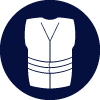
Metal Stud Wall Metal 17 04 05
Metal stud walls are made from strong lightweight uprights made from coated steel that is moulded into a range of profiles. These are base coated and galvanised to resist corrosion. Floor and ceiling profiles to interconnect the uprights are made in the same way. They are all malleable to suit most architectural designs.
Usage & Probable Locations
Metal stud walls and associated board finishes are used for internal walls and inner cavity walls of commercial, industrial and retail buildings. They are used to line the inside of buildings and to separate floor space into rooms, corridors and shafts. Metal stud walls are commonly lined with plasterboard or other board finish and filled with insulation for thermal, acoustic and fire protection.
Personal Protective Equipment
PPE requirements indicated are for guidance purposes only. DRIDS has identified the PPE that is mandatory on all demolition projects and ones that may be required subject to site specific Risk Assessment & Method Statement (RAMS). Hover over the icon to determine the types of PPE required for the removal of this material.
Removal, Segregation & Storage
Metal stud walls destined for recycling should be segregated into metal recycling skips. There is little need to store metal stud walls inside a building or under cover as they are robust against inclement weather. Small pieces of metal stud walls destined for the material recovery facility should be placed in the mixed waste skip.
Tools
Fixtures, Fittings & Connections
Metal stud walls are usually fixed in place with nails, rivets, nuts and bolts and power driven screws. Rivets may be used to partially fix floor and ceiling profiles. Metal stud walls and boards around window and door frames will be fixed in place with screws, nails and rivets. Electric services and cables will be run in the cavity of the stud wall and electric sockets and switch plates fixed to metal noggins between uprights. Insulation of various forms will sit within the stud wall cavity, sandwiched in place between the face boards which will commonly be plasterboard.
Health & Safety
Subject to task-specific Risk Assessment & Method Statement (RAMS). Use correct protective equipment for removing screws, nails, bolts and rivets. Wear gloves when handling metal stud walls with sharp edges or coated in paint to prevent irritation, cuts and metal splinters. Wear eye protection when using abrasive cutting tools and electric hand tools. Use suitable elevation equipment where needed. Wear face mask to prevent dust inhalation. Only use abrasive cutting tools if properly trained.










